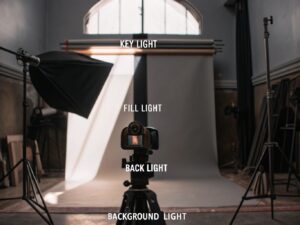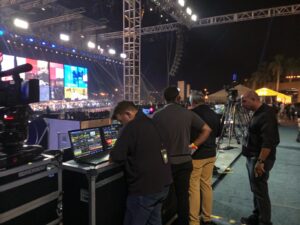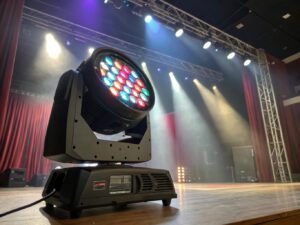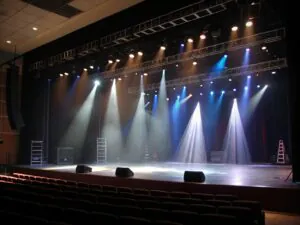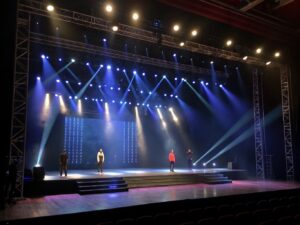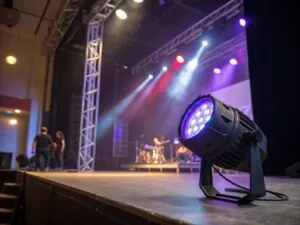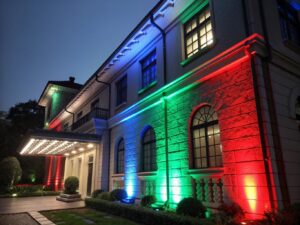
What Makes RGBW Color Mixing a Game-Changer in Compact LED Pars?
Are your RGB lights creating muddy pastels? Frustrated by the lack of a true, crisp white? Elevate your design with the superior color range of RGBW technology1.
RGBW LED Par Cans add a dedicated white LED chip to the standard red, green, and blue. This simple addition creates brighter, purer whites and a vastly expanded palette of delicate pastels2 and saturated colors that are impossible to achieve with RGB fixtures alone.

Over my 19 years in the lighting business, I've seen technology evolve at an incredible pace. I remember when just having colored LEDs was a revolution. But adding that single 'W' chip was one of the most practical and powerful advancements for fixtures like the humble par can. It's a change that solves real-world problems for technicians like you. It directly addresses the need for better quality light without complicating the setup. Let's break down exactly what this means for your designs.
What is the difference between an RGB LED and an RGBW LED?
Trying to make a clean white with an RGB fixture gives you a rainbow-fringed mess. This limitation compromises your entire color scheme and looks unprofessional on camera.
The key difference is a dedicated white LED emitter. RGB fixtures mix Red, Green, and Blue light to approximate white, which often appears bluish or discolored. RGBW fixtures include a separate White chip for a true, clean white and better pastels.

The difference is immediately obvious to a trained eye. When you try to create white with an RGB fixture, you're commanding three different points of light to combine. If you look closely, especially at the edges of the beam, you can often see distinct red, green, and blue shadows. We call this "color shadowing." It's not a clean look. An RGBW fixture solves this completely. By using a single, dedicated white diode, you get a pure, untainted source of white light. This is critical not just for stage washes, but also for video and broadcast. Cameras are very sensitive to these color inaccuracies. A mixed RGB white that looks passable to the eye can look terrible on screen. The 'W' in RGBW provides that clean, high-quality light that makes everything, and everyone, on stage look better.
RGB vs. RGBW at a Glance
| Feature | RGB LED | RGBW LED |
|---|---|---|
| White Quality | Mixed, often bluish or pinkish | Pure, dedicated white source |
| Pastel Colors | Muddy, low brightness | Clean, bright, and vibrant |
| Color Shadowing | Common on mixed white | Not an issue for white light |
| Best For | Basic color effects, accent lighting | Professional stage washes, video, theater |
What are LED par cans?
Need a versatile, powerful, and affordable lighting workhorse? Building a rig with bulky, hot, traditional lamps is inefficient and expensive. The modern solution is the cool and capable LED Par.
LED Par Cans are modern versions of classic Parabolic Aluminized Reflector lights. Instead of one hot lamp and a color gel, they use power-efficient LEDs (like RGBW) for instant color mixing, lower heat, and a much longer lifespan. They are essential stage lighting fixtures.

I spent the first part of my career hauling around heavy Par 64 cans. Each one needed a separate dimmer, heavy power cables, and a physical gel that you had to climb a ladder to change. The heat they produced was incredible. LED Par Cans changed everything. They are lightweight, which makes rigging faster and safer. They draw a fraction of the power, so you can put more lights on a single circuit. And because they run cool, they are much safer for performers on stage. For technicians, the biggest win is the internal DMX control and color mixing. The need to manage an inventory of color gels and change them by hand is gone forever. You can create any color you want, on demand, from your console. This transition to LED technology has made stage lighting more accessible, more creative, and more reliable.
Traditional Par vs. Modern LED Par
| Aspect | Traditional Par 64 (500W) | Modern RGBW LED Par |
|---|---|---|
| Power Draw | High (500W) | Low (~60W) |
| Heat Output | Extremely High | Very Low |
| Color Change | Manual Gel Change | Instant DMX Control |
| Lifespan | ~2,000 hours (lamp) | ~50,000+ hours (LEDs) |
| Weight | Heavy | Lightweight |
How do you mix colors on an LED fixture?
Confused by DMX channels and color values? Manually setting each color can be slow when you're under pressure. Understand the simple principle of additive mixing to unlock any color instantly.
You mix colors on an LED fixture using DMX control. Each primary color (Red, Green, Blue, White) is assigned a DMX channel. By adjusting the intensity value (0-255) of each channel from your console, you can create millions of different color combinations.

This process is based on the additive color model3. Unlike paint, where mixing colors makes them darker, light works the opposite way. Adding light makes things brighter. Your lighting console sends a number from 0 (off) to 255 (full brightness) to each color channel in the fixture. For an RGBW light, you typically have at least four channels to control. To get a vivid yellow, you would set Red to 255 and Green to 255, while leaving Blue and White at 0. To create a cool-looking cyan, you'd mix Green and Blue. The real magic comes with the white channel. You can create a nice deep blue, and then add a little bit of white to turn it into a soft sky blue without losing brightness. Here at Monalight, we also program our fixtures with virtual color wheels and pre-set macros, giving you quick access to perfectly calibrated colors without having to manually mix them every time.
DMX Mixing Examples (0-255 Scale)
| Desired Color | Red Value | Green Value | Blue Value | White Value |
|---|---|---|---|---|
| Amber | 255 | 191 | 0 | 0 |
| Magenta | 255 | 0 | 255 | 0 |
| Pure White | 0 | 0 | 0 | 255 |
| Light Pink | 255 | 0 | 128 | 150 |
What can RGBW LEDs achieve that RGB LEDs cannot?
Are your light pastels looking dull and unsaturated? Is your "white" light just not bright enough for a proper stage wash? RGB fixtures4 simply can't produce the range you need.
RGBW LEDs produce a true, high-quality white light that is impossible for standard RGB fixtures. This also enables the creation of a vast spectrum of clean, bright pastels (like light pink or sky blue) that look rich and professional.

This is where RGBW proves its worth every single time. There are two main achievements of RGBW that are impossible for RGB alone. First is the quality of white light. The dedicated white chip has a much higher Color Rendering Index (CRI)5. A high CRI means the light shows the true colors of costumes, sets, and especially skin tones. An RGB-mixed white will make people look unnatural. For any show with actors or live speakers, a high-CRI white from an RGBW fixture is non-negotiable. The second major advantage is creating pastel colors6. With an RGB light, to make a light blue, you have to run your blue channel at a very low intensity, which results in a dim, lifeless color. With an RGBW fixture, you can run the blue at full intensity and then mix in the white channel. This "tints" the blue, creating a powerful, bright pastel color that still has punch and vibrancy. It gives you a whole new toolbox of colors to work with.
Conclusion
RGBW LED Par Cans are essential tools for any serious lighting professional. The dedicated white channel provides superior whites and pastels, offering more creative freedom and professional results.
-
Explore how RGBW technology enhances lighting quality and color range for professional setups. ↩
-
Explore the vibrant pastel colors achievable with RGBW technology. ↩
-
Explore the principles of the additive color model and its application in lighting. ↩
-
Understand the limitations of RGB fixtures and how RGBW overcomes them. ↩
-
Learn about CRI and its significance in achieving accurate color representation. ↩
-
Find out how RGBW LEDs produce vibrant pastel colors for professional lighting. ↩
You may also be interested in:
